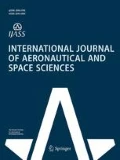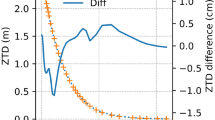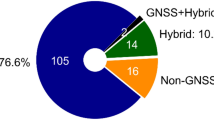Abstract
Aiming at the problem of insufficient availability in the satellite receiver autonomous integrity monitoring (RAIM) method, an improved aircraft autonomous integrity monitoring (AAIM) method aided by barometric altimeter based on weight optimization is proposed under the actual configuration of the airborne navigation system. The information of satellite navigation system and barometric altimeter is used to establish the observation equation of the integrated system. The algorithm for integrity monitoring and protection-level calculation is derived based on multiple solution separation, and a weight optimization is adopted to achieve a trade-off between position accuracy and integrity, which can improve the availability of AAIM method. The simulation experiment shows that when the number of visible stars is 5, the traditional method cannot effectively detect the satellite fault, and the positioning error is 43.65 m. The improved algorithm can effectively isolate the fault and reduce the positioning error to 0.37 m. Compared with the traditional RAIM algorithm and the Baro-aided AAIM algorithm, the proposed algorithm has a lower vertical protection threshold. Therefore, the algorithm in this paper improves the performance of satellite navigation system integrity monitoring and ensure the accuracy and reliability of the satellite navigation system.









Similar content being viewed by others
References
Liu M, Lai J, Li Z, Liu J (2016) An adaptive cubature Kalman filter algorithm for inertial and land-based navigation system. Aerosp Sci Technol 51:52–60
Call C, Ibis M, McDonald J, Vanderwerf K (2006) Performance of honeywell's inertial/GPS hybrid (HIGH) for RNP operations. In: Position, location, and navigation symposium, 2006 IEEE/ION, IEEE, p 244
Bhatti UI, Ochieng WY (2007) Failure modes and models for integrated GPS/INS systems. J Navig 60(2):327–348
Feng S, Ochieng WY, Walsh D, Ioannides R (2006) A measurement domain receiver autonomous integrity monitoring algorithm. GPS Solut 10(2):85–96
Milner CD, Ochieng WY (2011) Weighted RAIM for APV: the ideal protection level. J Navig 64(1):61–73
Rife J, Phelts RE (2008) Formulation of a time-varying maximum allowable error for ground-based augmentation systems. IEEE Trans Aerosp Electron Syst 44(2):548–560
Lee YC (2007) Two new RAIM methods based on the optimally weighted average solution (OWAS) concept. Navigation 54(4):333–345
Blanch J, Walter T, Enge P (2010) RAIM with optimal integrity and continuity allocations under multiple failures. IEEE Trans Aerosp Electron Syst 46(3):1235–1247
Blanch J, Walter T, Enge P (2013) Optimal positioning for advanced RAIM. Navig J Inst Navig 60(4):279–289
Hewitson S, Wang J (2006) GNSS receiver autonomous integrity monitoring (RAIM) performance analysis. GPS Solut 10(3):155–170
McDonald J, Kendrick J (2008) Benefits of tightly coupled GPS/IRS for RNP operations in terrain challenged airports. In: Position, location and navigation symposium, 2008 IEEE/ION, IEEE, pp 294–303
Lee YC, O'Laughlin DG (2000) Performance analysis of a tightly coupled GPS/inertial system for two integrity monitoring methods 1. Navigation 47(3):175–189
Bruggemann TS, Greer DG, Walker RA (2011) GPS fault detection with IMU and aircraft dynamics. IEEE Trans Aerosp Electron Syst 47(1):305–316
Bhatti UI, Ochieng WY, Feng S (2012) Performance of rate detector algorithms for an integrated GPS/INS system in the presence of slowly growing error. GPS Solut 16(3):293–301
Tang W, Howell G, Tsai Y-H (2005) Barometric altimeter short-term accuracy analysis. IEEE Aerosp Electron Syst Mag 20(12):24–26
Gaglione S, Angrisano A, Castaldo G, Gioia C, Innac A, Perrotta L, Del Core G, Troisi S (2015) GPS/Barometer augmented navigation system: integration and integrity monitoring. In: Metrology for aerospace (MetroAeroSpace), 2015 IEEE, IEEE, pp 166–171
Jan S-S, Gebre-Egziabher D, Walter T, Enge P (2008) Improving GPS-based landing system performance using an empirical barometric altimeter confidence bound. IEEE Trans Aerosp Electron Syst 44(1):127–146
Hwang PY, Brown RG (2006) RAIM-FDE revisited: a new breakthrough in availability performance with nioRAIM (novel integrity-optimized RAIM). Navigation 53(1):41–51
Joerger M, Stevanovic S, Langel S, Pervan B (2016) Integrity risk minimisation in RAIM part 1: optimal detector design. J Navig 69(3):449–467
Zhi W, Wang Z, Zhu Y, Li R (2017) Availability prediction method for EGNOS. GPS Solut 21(3):985–997
Ge Y, Wang Z, Zhu Y (2017) Reduced ARAIM monitoring subset method based on satellites in different orbital planes. GPS Solut 21(4):1443–1456
Kelly R, Davis J (1994) Required navigation performance (RNP) for precision approach and landing with GNSS application. Navigation 41(1):1–30
Milner CD, Ochieng WY (2010) A fast and efficient integrity computation for non-precision approach performance assessment. GPS Solut 14(2):193–205
Jiang Y, Wang J (2016) A new approach to calculate the horizontal protection level. J Navig 69(1):57–74
Hwang PY, Brown RG (2005) NIORAIM integrity monitoring performance in simultaneous two-fault satellite scenarios. In: ION GNSS, pp 1760–1771
Inc R (2003) Minimum-aviation system performance standards: required navigation performance for area navigation. Appendix C: Navigation System Requirements and Infrastructure Characteristics. RTCA, Washington, DC, USA
RTCA I (2002) Minimum operating standards for required navigation performance for area navigation. Document DO-283. RTCA, Inc., Washington, DC, USA
Acknowledgements
This work is partially supported by Jiangsu provincial SixTalent Peaks (2015-XXRJ-005), Jiangsu Province Qing Lan Project, National Natural Science Foundation of China (61703207, 61973160), Jiangsu Provincial Natural Science Foundation of China (BK20170801), Aeronautical Science Foundation of China (2017ZC52017), Civil Aircraft Project of Ministry of Industry and Information (2018-S-36).
Author information
Authors and Affiliations
Corresponding author
Additional information
Publisher's Note
Springer Nature remains neutral with regard to jurisdictional claims in published maps and institutional affiliations.
Rights and permissions
About this article
Cite this article
Xu, X., Lai, J., Liu, M. et al. An Improved Weight Optimization AAIM Method Aided by Barometric Altimeter. Int. J. Aeronaut. Space Sci. 22, 638–647 (2021). https://doi.org/10.1007/s42405-020-00321-3
Received:
Revised:
Accepted:
Published:
Issue Date:
DOI: https://doi.org/10.1007/s42405-020-00321-3




